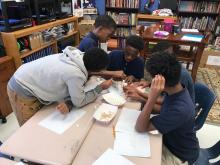Learning Blade
Impact
Learning Blade is a complete interactive toolbox that has been proven to increase STEM career awareness and interest while practicing academic skills. Students learn about over 100 different careers and technologies while working on 12 different virtual “missions.” The missions engage all students, including girls and minorities, by organizing the content around real-world issues that focus on helping people and communities. Components include online lessons, hands-on activities, coding activities, design thinking exercises, 3D printing resources and parent engagement handouts. As of the end of December 2019, students have completed over 3,000,000 activities in the system in over 20 states, including Arkansas, Tennessee, Missouri, Alabama, Kentucky and South Carolina.
Accomplished
- Need Accomplished
- Evaluation Developing
- Sustainability Accomplished
- Replication & Scalability Accomplished
- Partnerships Accomplished
- Capacity Accomplished
- Challenging & Relevant Content Accomplished
- STEM Practices Developing
- Inspiration Accomplished
- Under-Represented Groups Developing

The Learning Blade program is a tremendous asset in my STEM program. Learning Blade exposes students to real-life applications of math and science with problem-based missions to complete. After trying different supplemental curriculum, Learning Blade is by far my students’ favorite
Kenwood Middle School, Tennessee
Design Principles
The programs in this database clear a high bar. STEMworks reviewed each program against the Design Principles for Effective STEM Philanthropy. Programs must be Accomplished () across all Design Principles, or be Developing (
) in a maximum of three areas.
Overarching Principles
-
Need Accomplished
Identify and target a compelling and well-defined need.
-
Evaluation Developing
Use rigorous evaluation to continuously measure and inform progress towards the compelling need identified.
-
Sustainability Accomplished
Ensure work is sustainable.
-
Replication & Scalability Accomplished
Demonstrate replicability and scalability.
-
Partnerships Accomplished
Create high impact partnerships.
-
Capacity Accomplished
Ensure organizational capacity to achieve goals.
STEM Principles
-
Challenging & Relevant Content Accomplished
Offer challenging and relevant STEM content for the target audience.
-
STEM Practices Developing
Incorporate and encourage STEM practices.
-
Inspiration Accomplished
Inspire interest and engagement in STEM.
-
Under-Represented Groups Developing
Identify and address the needs of under-represented groups.
Program Overview
The program is designed to create a STEM context for all academic classrooms including English, math, social studies and science. Students solve the missions while learning about associated STEM careers and technologies by completing short online lessons that demonstrate the connection between the STEM topics and academic skills. As students complete the lessons, they answer questions tied to specific academic standards. Each mission also includes hands-on activities, design thinking exercises, 3D printing resources and parent engagement handouts. Reports available to the teacher provide detailed information on student and class performance by individual academic standards. Learning Blade is web-based and includes complete student management and reporting tools. This allows teachers with no STEM experience or specialized equipment to be able to create a STEM context for supplemental academic instruction. Learning Blade is also an ideal way to provide a broad STEM career awareness to students in career development classes or after school programs. Currently Learning Blade is designed to address middle school standards and is used in grades 5 through 9.
Funders and Partners
Tennessee statewide deployment is funded by the state’s Department of Education through the Tennessee STEM Innovation Network. Arkansas deployment is funded by the Governor’s Computer Science Initiative through the Department of Education and the Arkansas Public Schools Resource Center. Missouri is funded by the MO Department of Elementary and Secondary Education. Funding in Alabama is a joint venture of the Alabama Department of Commerce, the Governor’s Office and The Boeing Company, and is partially funded with Federal Funds made available to the State of Alabama Department of Commerce by the U. S. Department of Labor/Employment and Training Administration as the Grantor. Additional support has been provided by TATA Consultancy Services, the Federal GEARUp program, Berea College, KY, the Lightweight Innovations for Tomorrow (LIFT) Institute, Battelle, and district funding, corporations and foundations.
